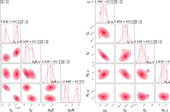 IIA SARANG SHAH
IIA SARANG SHAHCasting light on degeneracies: A comprehensive study of lightcurve variations in microlensing events OGLE-2017-BLG-0103 and OGLE-2017-BLG-0192
This study investigates orbital parallax in gravitational microlensing events, focusing on OGLE-2017-BLG-0103 and OGLE-2017-BLG-0192. For events with timescales ≤60 days, a Jerk-Parallax degeneracy arises due to high Jerk velocity (v˜j), causing a fourfold continuous parallax degeneracy. OGLE-2017-BLG-0103, after incorporating orbital parallax, reveals four discrete degenerate parallax solutions, while OGLE-2017-BLG-0192 exhibits four discrete solutions without degeneracy. The asymmetric lightcurve of OGLE-2017-BLG-0103 suggests a more probable model where Xallarap is added to the parallax model, introducing tension. The galactic model analysis predicts a very low-mass stellar lens for OGLE-2017-BLG-0192. For OGLE-2017-BLG-0103, degenerate solutions suggest a low-mass star or a darker lens in the disk, while the Xallarap+Parallax model also predicts a stellar lens in the bulge, with the source being a solar-type star orbited by a dwarf star. This study presents five degenerate solutions for OGLE-2017-BLG-0103, emphasizing the potential for confirmation through high-resolution Adaptive Optics observations with Extremely Large Telescopes in the future. The complexities of degenerate scenarios in these microlensing events underscore the need to analyze special single-lens events in the Roman Telescope Era.
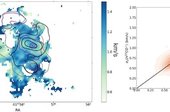 IIA ARCHANA SOAM
IIA ARCHANA SOAMATOMS: ALMA three-millimetre observations of massive star-forming regions – XVI. Neutral versus ion line widths
It has been suggested that the line width of ions in molecular clouds is narrower than that of the co-existing neutral particles, which has been interpreted as an indication of the decoupling of neutral turbulence from magnetic fields within a partially ionized environment. We calculate the principal component analysis (PCA) correlation coefficients of CCH versus H13CO+ and H13CN versus H13CO+. We find aside from H13CN, CCH could also be strongly spatial correlated with H13CO+ in high-mass star-forming regions. CCH and H13CO+ line emissions are strongly spatial correlated with each other in 48 per cent sources with a PCA correlation coefficient over 0.7. So, we investigate the ambipolar diffusion (AD) effect using CCH and H13CO+ lines as a neutral/ion pair in a sample of 129 high-mass star-forming clumps. We conduct a careful analysis of line widths of the CCH–H13CO+ pair pixel-by-pixel in 12 sources, which show a strong correlation in CCH–H13CO+ emission and no obvious outflows or multiple velocity components. The mean velocity dispersion of CCH is about the same as H13CO+ in 12 sources. In low-density regions of most sources, CCH shows a broader velocity dispersion than H13CO+. However, the AD effect is not significant from a statistical point of view.
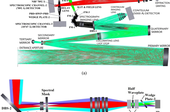 IIA SASIKUMAR RAJA, K
IIA SASIKUMAR RAJA, KCalibration of spectropolarimetry channel of visible emission line coronagraph onboard Aditya-L1
The magnetic field strength and its topology play an important role in understanding the formation, evolution, and dynamics of the solar corona. Also, it plays a significant role in addressing long-standing mysteries such as coronal heating problem, origin and propagation of coronal mass ejections, drivers of space weather, origin and acceleration of solar wind, and so on. Despite having photospheric magnetograms for decades, we do not have reliable observations of coronal magnetic field strengths today. To measure the coronal magnetic field precisely, the spectropolarimetry channel of the Visible Emission Line Coronagraph (VELC) on board the Aditya-L1 mission is designed. Using the observations of coronal emission line Fe XIII [10747Å ], it is possible to generate full Stokes maps (I, Q, U, and V) that help in estimating the Line-of-Sight (LOS) magnetic field strength and to derive the magnetic field topology maps of solar corona in the Field of View (FOV) (1.05 – 1.5 R⊙). In this article, we summarize the instrumental details of the spectropolarimetry channel and detailed calibration procedures adopted to derive the modulation and demodulation matrices. Furthermore, we have applied the derived demodulation matrices to the observed data in the laboratory and studied their performance.
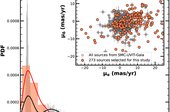 IIA STALIN, C. S
IIA STALIN, C. SDetection of a new sample of Galactic white dwarfs in the direction of the Small Magellanic Cloud
In this study, we demonstrate the efficacy of the Ultraviolet Imaging Telescope (UVIT) in identifying and characterizing white dwarfs (WDs) within the Milky Way Galaxy. Methods. Leveraging the UVIT point-source catalogue towards the Small Magellanic Cloud and cross-matching it with Gaia DR3 data, we identified 43 single WDs (37 new detections), 13 new WD+main-sequence candidates, and 161 UV bright main-sequence stars by analysing their spectral energy distributions. Using the WD evolutionary models, we determined the masses, effective temperatures, and cooling ages of these identified WDs. Results. The masses of these WDs range from 0.2 to 1.3 M⊙ and the effective temperatures (Te f f) lie between 10 000 K to 15 000 K, with cooling ages spanning 0.1–2 Gyr. Notably, we detect WDs that are hotter than reported in the literature, which we attribute to the sensitivity of UVIT. Furthermore, we report the detection of 20 new extremely low-mass candidates from our analysis. Future spectroscopic studies of the extremely low-mass candidates will help us understand the formation scenarios of these exotic objects. Despite limitations in Gaia DR3 distance measurements for optically faint WDs, we provide a crude estimate of the WD space density within 1kpc of 1.3 × 10−3 pc−3, which is higher than previous estimates in the literature. Conclusions. Our results underscore the instrumental capabilities of UVIT and anticipate forthcoming UV missions such as INSIST for systematic WD discovery. Our method sets a precedent for future analyses in other UVIT fields to find more WDs and perform spectroscopic studies to verify their candidacy.
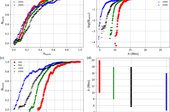 IIA PIYALI CHATTERJEE
IIA PIYALI CHATTERJEEDependence of spicule properties on the magnetic field—Results from magnetohydrodynamics simulations
Solar spicules are plasma jets observed in the interface region between the visible solar surface and the corona. At any given time, there is a forest of spicules originating in the chromosphere of the Sun. While various models attempt to elucidate their origin and characteristics, here, we consider the one driven by the magnetoconvection undulations. The radiative magnetohydrodynamic (rMHD) equations are solved using PENCIL CODE with a spatial resolution of 16 km using various magnetic field strengths. The obtained rMHD simulation data are investigated to unveil the various trends in spicular properties as a function of the applied magnetic fields. The important outcome of this study is the finding of a consistent reduction in both the number density and the maximum height reached by spicules as magnetic field strength increases. We also use parabolic fitting on time–distance curves of spicules that are taller than the 75th percentile in the distribution, in order to find a relation between the deceleration of the spicule tip and the magnetic field strength. Our results offer insights into the response of solar spicules to magnetic field strength.
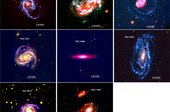 IIA PAYEL NANDI
IIA PAYEL NANDIUVIT survey of the host galaxies of active galactic nuclei. I. star formation scenarios
Circumnuclear star formation (SF) is generally seen in galaxies hosting active galactic nuclei (AGN); however, the connection between the AGN activity and SF in them is less well understood. To explore this connection on scales of a few tens of parsecs to a few tens of kiloparsecs and larger, we carried out an investigation of SF in seven Seyfert-type AGN and one low-ionization nuclear emission-line region galaxy, using observations with the Ultraviolet Imaging Telescope on board AstroSat in the near-ultraviolet (2000–3000 Å) and far-ultraviolet (1300−1800 Å) bands. A total of 1742 star-forming regions were identified, having size scales of 0.010–63.642 kpc2. Considering all the galaxies, we found a positive correlation between their total surface density of SF (ΣSFR) and extinction. For five galaxies, namely NGC 1365, NGC 4051, NGC 4321, NGC 5033, and NGC 6814, we found a gradual decrease of both extinction and ΣSFR from the centre to the outer regions. Four sources are found to lie in the main sequence of star-forming galaxies, and the other four lie away from it. We found the ratio of the star formation rate (SFR) in the nuclear region to the total SFR to be positively correlated with the Eddington ratio. This points to the influence of AGN in enhancing the SF characteristics of the hosts. However, the impact is dominant only in the central nuclear region and has no significant effect on the larger scales probed in this work
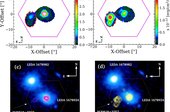 IIA MOUSUMI DAS
IIA MOUSUMI DASAn accreting supermassive black hole buried in a faint dwarf galaxy
In the last decade, there have been several discoveries of active galactic nuclei (AGN) in dwarf galaxies including an AGN in an ultracompact dwarf galaxy with a black hole mass >106 Me. However, finding a supermassive black hole (SMBH) in a dwarf low surface brightness (LSB) galaxy is rare. We report the discovery of a Seyfert type 2 class AGN that is associated with a nuclear SMBH of mass ∼6.5 × 106 Me in a dwarf LSB galaxy (μ0,r > 23.8 mag arcsec−2) that we denote by MJ0818+2257. The galaxy was previously thought to be an outlying emission blob around the large spiral galaxy LEDA 1678924. In our current analysis, which includes the detection of the optical counterpart of MJ0818+2257, we study its ionized gas kinematics and find that the dynamical mass within the ionized gas disk is ∼5.3 × 109 Me. This is comparable to its stellar mass, which is ∼3 × 109 Me, and suggests that MJ0818+2257 is moderately dark matter dominated within the stellar disk. The SMBH-mass-togalaxy-stellar-mass ratio is MBH/M(*) > 0.022, which is high compared to disk galaxies. Our detection of an SMBH in a bulgeless LSB dwarf galaxy raises questions about the growth of SMBHs in low-luminosity galaxies and suggests the possibility of detecting heavy seed black holes from early epochs in LSB dwarf galaxies in the low-redshift Universe.
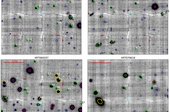 IIA DEEPAK EAPPACHEN
IIA DEEPAK EAPPACHENRedshifts of candidate host galaxies of four fast X-ray transients using VLT/MUSE
Fast X-ray transients (FXTs) are X-ray flares that last from minutes to hours. Multi-wavelength counterparts to these FXTs have proven hard to find. As a result, distance measurements are made through indirect methods such as a host galaxy identification. Of the three main models proposed for FXTs, that is, supernova shock breakout emission (SN SBO), binary neutron star (BNS) mergers, and tidal dirsuption events (TDEs) of an intermediate-mass black hole (IMBH) disrupting a white dwarf (WD), the SN SBO predicts a much lower maximum peak X-ray luminosity (LX,peak). If the distance to FXTs were to be obtained, it would be a powerful probe for investigating the nature of these FXTs. Aims. We aim to obtain distance measurements to four FXTs by identifying candidate host galaxies. Through a redshift measurement of the candidate host galaxies, we derive LX,peak and the projected offset between the candidate host galaxy and the FXT. Methods. We obtained Very Large Telescope (VLT)/Multi Unit Spectroscopic Explorer (MUSE) observations of a sample of FXTs. We report the redshift of between 13 and 22 galaxies per FXT. We used these redshifts to calculate the distance, LX,peak and the projected offsets between the FXT position and the position of the sources. Additionally, we computed the chance alignment probabilities for these sources with the FXT postitions. Results. We find LX,peak > 1044 erg s−1 when we assume that any of the sources with a redshift measurement is the true host galaxy of the corresponding FXT. For XRT 100831, we find a very faint galaxy (mR,AB = 26.5 ± 0.3, z ∼ 1.22, LX,peak ∼ 8 × 1045 erg s−1 if the FXT is at this distance) within the 1σ uncertainty region with a chance alignment probability of 0.04. For XRT 060207, we find a candidate host galaxy at z = 0.939 with a low chance alignment probability within the 1σ uncertainty region. However, we also report the detection of a late-type star within the 3σ uncertainty region with a similar chance alignment probability. For the remaining FXTs (XRT 030511 and XRT 070618), we find no sources within their 3σ uncertainty regions. The projected offsets between the galaxies and the FXT positions is >33 kpc at 1σ uncertainty. Therefore, if one of these candidate host galaxies turns out to be the true host galaxy, it would imply that the FXT progenitor originated from a system that received a significant kick velocity at formation. Conclusions. We rule out an SN SBO nature for all FXTs based on LX,peak and the projected offsets between the FXT position and the sources, assuming any of the candidate host galaxies with a redshift determination is the true host galaxy to the FXT. For XRT 100831, we conclude that the detected galaxy within the 1σ uncertainty position is likely to be the host galaxy of this FXT based on the chance alignment probability. From the available information, we are not able to determine whether XRT 060207 originated from the galaxy found within 1σ of the FXT position or was due to a flare from the late-type star detected within the 3σ uncertainty region. Based on LX,peak and the offsets within our sample, we are not able to distinguish between the BNS merger and the IMBD-WD TDE progenitor model. However, for the candidate host galaxies with an offset &30 kpc, we can conclude that the IMBH-WD TDE is unlikely due to the large offset.
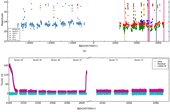 IIA ARTI JOSHI
IIA ARTI JOSHIUnveiling the nature of two dwarf novae: CRTS J080846.2+313106 and V416 Dra
We present the analysis of optical photometric and spectroscopic observations of two non-magnetic cataclysmic variables, namely CRTS J080846.2+313106 and V416 Dra. We find CRTS J080846.2+313106 to vary with a period of 4.9116 ± 0.0003 h, which was not found in earlier studies and which we provisionally suggest is the orbital period of the system. In both long-period systems, the observed dominant signal at the second harmonic of the orbital frequency and the orbital modulation during quiescence are suggestive of ellipsoidal variation from changing aspects of the secondary, with an additional contribution from the accretion stream or hotspot. However, during the outburst, the hotspot itself is overwhelmed by the increased brightness, which is possibly associated with the accretion disc. The mid-eclipse phase for V416 Dra occurs earlier and the width of the eclipse is greater during outbursts compared to quiescence, suggesting an increased accretion disc radius during outbursts. Furthermore, from our investigation of the accretion disc eclipse in V416 Dra, we find that a total disc eclipse is possible during quiescence, whereas the disc seems to be partially obscured during outbursts, which further signifies that the disc may grow in size as the outburst progresses. The optical spectra of CRTS J080846.2+313106 and V416 Dra are typical of dwarf novae during quiescence, and they both show a significant contribution from the M2-4V secondary. The light curve patterns, orbital periods, and spectra observed in the two systems look remarkably similar, and seem to resemble the characteristics of U Gem-type dwarf novae.
 IIA ARPIT KUMAR SHRIVASTAV
IIA ARPIT KUMAR SHRIVASTAVEffects of coronal rain on decayless kink oscillations of coronal loops
Decayless kink oscillations are ubiquitously observed in active region coronal loops with an almost constant amplitude for several cycles. Decayless kink oscillations of coronal loops triggered by coronal rain have been analyzed, but the impact of coronal rain formation in an already oscillating loop is unclear. As kink oscillations can help diagnose the local plasma conditions, it is important to understand how these are affected by coronal rain phenomena. In this study, we present the analysis of an event of coronal rain that occurred on 25 April 2014 and was simultaneously observed by Slit-Jaw Imager (SJI) on board Interface Region Imaging Spectrograph (IRIS) and Atmospheric Imaging Assembly (AIA) on board the Solar Dynamic Observatory (SDO). We investigated the oscillation properties of the coronal loop in AIA images before and after the appearance of coronal rain as observed by SJI. We find signatures of decayless oscillations before and after coronal rain at similar positions to those found during coronal rain. The individual cases show a greater amplitude and period during coronal rain. The mean period is increased by 1.3 times during coronal rain, while the average amplitude is increased by 2 times during rain, in agreement with the expected density increase from coronal rain. The existence of the oscillations in the same loop at the time of no coronal rain indicates the presence of a footpoint driver. The properties of the observed oscillations during coronal rain can result from the combined contribution of coronal rain and a footpoint driver. The oscillation amplitude associated with coronal rain is approximated to be 0.14 Mm. The properties of decayless oscillations are considerably affected by coronal rain, and without prior knowledge of coronal rain in the loop, a significant discrepancy can arise from coronal seismology with respect to the true values.